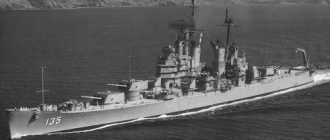Want information about the USS George De 697 Korean War? Read more about the Buckley class destroyer escort used in the Korean War USS George De 697…
USS George De 697 Korean War is identified as a Buckley class destroyer escort. It was the second ship used by the United States Navy named after Seaman Second Class Eugene F. George who lived from 1925 till 1942. He award the Navy Cross posthumously, which recognized his heroic service on board the USS San Francisco during the Naval Battle of Guadalcanal.
USS George De 697 was laid down on May 22, 1943. Its construction is credited to the Michigan-based Defoe Shipbuilding Company. USS George De 697 was inaugurated by the mother of Seaman George on August 14, 1943. The ceremony took place in New Orleans, Louisiana where the vessel was commissioned. The first in command of the vessel was Lieut. Commander J.B. Page who was given command of the vessel on November 20, 1943.
Role of the USS George De 697 in World War II
After a Bermuda shakedown the vessel was sailed out from Boston Massachusetts in January 1944 in order to escort the merchantmen from Norfolk, Virginia all the way to Noumea in New Caledonia. During the consolidation operations the vessel was utilized to escort transports to the Admiralties, New Hebrides and Solomon Islands until the spring of 1944.
It was part of the most successful anti-submarine expedition in the Solomon Islands and sank six Imperial Japanese Navy submarines during its patrol duties in the Pacific War. It continued to function in different operations including the Liberation of Philippines. In 1944 and 1945 it was utilized to escort convoys and ships from different regions while taking part in the battle of Iwo Jima. A noteworthy achievement was the rescue of three survivors from a B-29 off the coast of Iwo Jima.
Role of the USS George De 697 Korean War
The vessel performed spectacular duties during all of its combat operations in World War II. During the Korean War it was part of hunter and killer operations. Docked in the Western Pacific it moved along the Japanese coast line and assisted from Shanghai and Tsingtao. Its main role was to support the Chinese Nationalist troops and American troops in their operations against the Communist occupation in North China. It continued on during the Korean War to serve in hunter and killer operations along with assisting in the screening during the Korean War. It was finally struck from the American Naval Vessel Register in the 1969 and then eventually sold as a scrap in the 1970.





